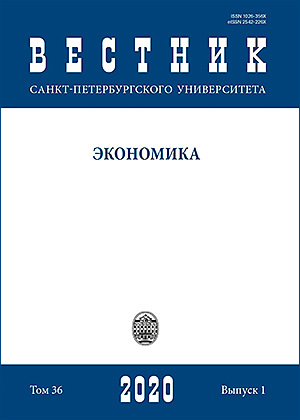Dividend policy as a factor for managing company value: Comparing trends in emerging markets
DOI:
https://doi.org/10.21638/spbu05.2020.105Abstract
Stock markets, which are a kind of catalyst for the level of development and dynamics of national and regional economies, have attracted the attention of researchers and practitioners, especially in emerging markets. The gradual transformation of emerging to developed market in terms of basic parameters cannot, by definition, be standardized and homogeneous from a regional aspect. The subject of this article is the formulation and testing of hypotheses about the influence of various dividend policy options on the value of oil and gas companies in emerging markets. In particular, we compare two estimates: (a) actual value of the company according to market data; and (b) theoretical (intrinsic) value of the company calculated on the basis of forecast data on systematic dividend payments using the simulation method (Monte Carlo method). The identification of statistically significant relationships between these estimates allows us to build a real mechanism for managing the company’s value in the context of the Value-Based Management (VBM) model. The logic and methodology of modeling and assessing the intrinsic value of the company, substantiated by the authors, was tested on actual publicly reported data of the largest listed companies in the oil and gas sector in a number of emerging markets in various regions of the world. The choice of sector was determined by particularities of the development of these companies, in particular the existence and certain continuity of the dividend policy. In developed markets, modeling business value in conjunction with dividend payments has been studied since the mid 1970s. The specifics of emerging markets (including the Russian case) are such that in fact only in recent years it has become possible to conduct research aimed at identifying the characteristics of the dividend policy of companies represented in these markets. Until recently, a relatively small history of dividend payments did not allow the construction of more or less reasonable hypotheses about trends and features. Moreover, results obtained were largely insignificant from the standpoint of statistical methods (an extremely small amount of data). It was not necessary to talk about a certain continuity of the dividend policy in the context of a rather stochastic procedure for accruing dividends at an early stage of public business in emerging markets. The situation has begun to change in recent years. The authors of this article substantiate the assumption that the existence of a successive dividend policy is an indispensable condition for the transition of the emerging stock market to the developed category.
Keywords:
emerging markets, Intrinsic (fundamental) value, company value, equity, market capitalization, CAPM, dividend policy, VBM, ROE, Monte Carlo method
Downloads
References
References in Latin Alphabet
Downloads
Published
How to Cite
Issue
Section
License
Articles of the St Petersburg University Journal of Economic Studies are open access distributed under the terms of the License Agreement with Saint Petersburg State University, which permits to the authors unrestricted distribution and self-archiving free of charge.






